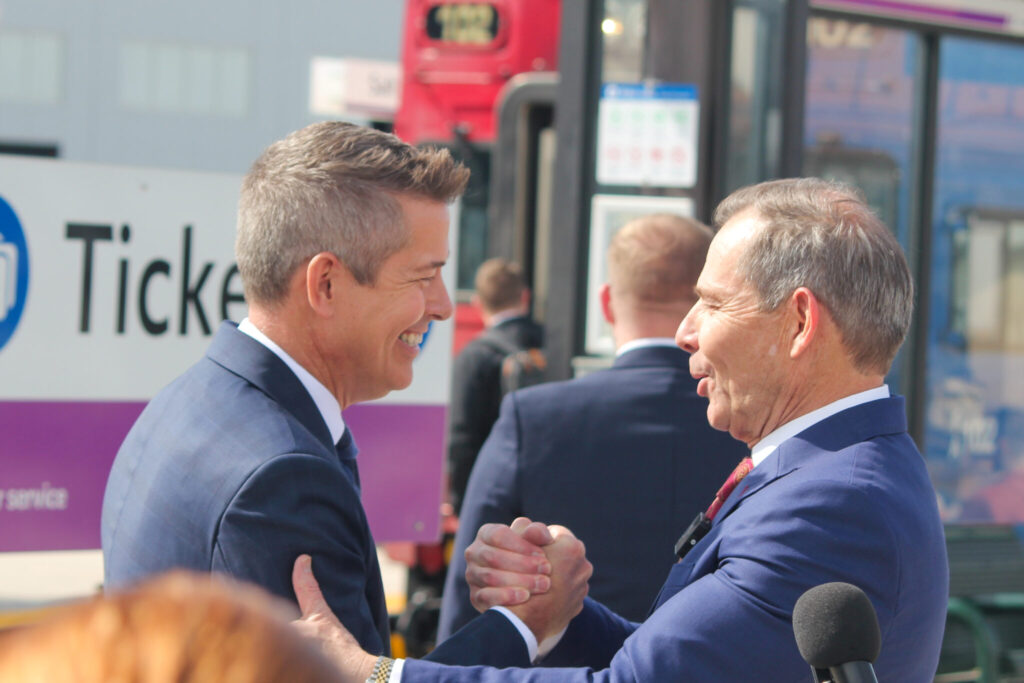Olympics
Transportation secretary: Utah, feds must invest in transit to support growth, prepare for Olympics

U.S. Secretary of Transportation Sean Duffy rides on a Frontrunner train with U.S. Sen. John Curtis, R-Utah, in Salt Lake City during a media event on Monday, April 7, 2025. Photo: McKenzie Romero/Utah News Dispatch
Over the rumble and rattle of an about 30-minute FrontRunner ride, Utah leaders eagerly pitched U.S. Transportation Secretary Sean Duffy on how supporting transit is key to managing the state’s explosive growth.
Cashing in on an invitation from Republican Utah Sen. John Curtis, who Duffy said approached him about plans for FrontRunner as soon as he was nominated for the post, the secretary boarded the southbound train at Salt Lake Central Station on Monday afternoon for a jaunt to the next station, where the entire contingent crossed the platform to a second train waiting to take them back.
Riding first on the ground level and then upstairs on the double-decker cars, Duffy’s fellow passengers pointed out the windows to Utah’s mountains, new housing developments along the line, and Intermountain Health’s massive Murray hospital, complete with its own TRAX stop.

Speaking quickly in the few minutes they had, they shared stories of adult children living in parents’ basements in the wake of a housing affordability and supply crisis, while praising the transit system’s access to key locations on the Wasatch Front, like the University of Utah, and free fares for students, some of whom can now choose not to own cars.
“Isn’t that a different conversation? What kids don’t want licenses and cars these days?” Duffy quipped back.
Flanked by Curtis and Rep. Celeste Maloy, R-Utah, who noted she was representing all of Utah’s U.S. House representatives, Duffy took a moment after returning to the station to praise Utah’s transit as “doing it the right way.”
“From my perspective at the Department of Transportation, I want to invest in great transit projects, the ones that are on budget, that are clean, that are safe, that move people, that actually have projections on ridership and actually meet those projections or exceed those projections, not give me projections, and then come in with lower ridership, and they cost more money,” Duffy said. “You may be an example for other communities to look at as a case study on how they could do it and do it better.”
The sunny review of transit in Utah — the state with the third-highest rate of car ownership, at 96% of households — was starkly different from Duffy’s comments last week during a brief ride on the New York City subway with Mayor Eric Adams, where the secretary bemoaned crime, blasted the city’s congestion pricing plan as forcing New Yorkers onto trains because it’s too expensive to drive, and repeated threats to withhold federal funding.
Curtis told reporters that during Duffy’s Utah visit he had explained to the secretary about the state’s distinctive population distribution, with “80 or 85% of our population in this narrow little corridor, and then we have a vast rural part of the state.”
“We’re trying to provide transportation for all of them, and it’s key to be able to have an effective FrontRunner, TRAX, bus system, in addition to our hard surface road area, all that comes together to be able to accommodate the massive growth,” Curtis said.
When asked how President Donald Trump’s tariff strategy, which has tanked global markets while stoking fears of rising prices and economic recession, could impact federal investments in transit, Duffy was quick to stand by the president with an optimistic endorsement of tariffs as “a massive revenue driver into the federal coffers” that can then be invested across the country, including in projects like roads and bridges.
In a follow-up about tariffs’ impacts on Americans’ personal finances, Curtis was more reserved, saying “we’ve all seen this before, right?”
“This is a long-term investment we’re making as a country. I’m very, very sympathetic, particularly with small businesses that are dealing with tariffs, and we’ll see where this goes,” Curtis said. “But we’re clearly on this path that we’re committed to, and I think we in the Senate need to do all we can to get a good runway for our small businesses and bring predictability into this as well.”
Utah Department of Transportation executive director Carlos Braceras said following the event he believed Duffy had heard Utah’s message that as the state grows, it will need to build up infrastructure — which means roads and bridges, as well as transit.
“They like Utah, because they see Utah as a place that’s innovative. We’re very cost effective, and we move fast,” Braceras said of the state’s federal partners.
As federal funds are slashed in Washington, D.C., Braceras said he isn’t nervous about any Utah transportation projects. Long-term formula funding for transportation doesn’t appear to be in jeopardy, he said, while any discretionary grant funding that does — or doesn’t — come through for the state “is kind of that sugar on top.”
Looking at not just the state’s current transit needs and projected growth, but at Salt Lake City and Utah hosting the 2034 Winter Olympics, Duffy emphasized the need for a positive partnership between Utah’s state and federal leaders and the Trump administration.
“This is not just Utah. This is America that presents itself at the Winter Olympics, and making sure we make the right investments and we have the right partnership amongst your federal delegation, your state representatives, but also the administration is key to make sure we get it right,” Duffy said.
Written



















